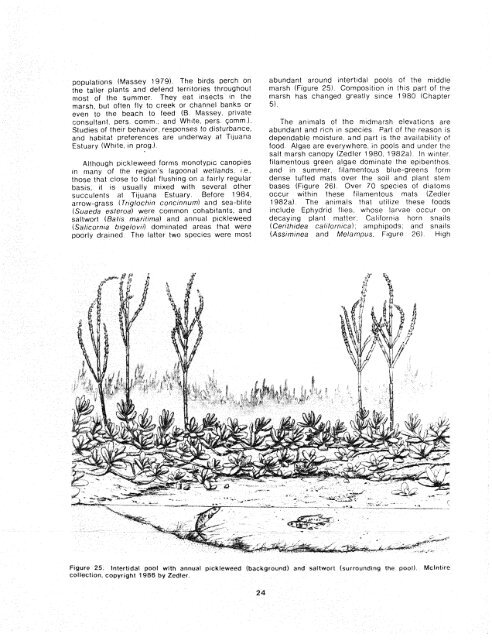The Ecology of Tijuana Estuary, California: An Estuarine Profile
The Ecology of Tijuana Estuary, California: An Estuarine Profile
The Ecology of Tijuana Estuary, California: An Estuarine Profile
You also want an ePaper? Increase the reach of your titles
YUMPU automatically turns print PDFs into web optimized ePapers that Google loves.
populations (Massey 1979) <strong>The</strong> brrds perch on<br />
the taller piants and defend territories throughout<br />
most <strong>of</strong> the summer <strong>The</strong>y eat insects in the<br />
marsh, but <strong>of</strong>ten fly lo creek or channel banks or<br />
even to the beach lo feed (B Massey, prrvate<br />
consultant, pers comm , and White. pers Comm 1.<br />
Sttrdles <strong>of</strong> aherr behaylor, responses to drsturbance.<br />
and habitat preferences are underway at <strong>Tijuana</strong><br />
<strong>Estuary</strong> (WhfPe, rn prog 1<br />
Although plckleweed forms. monotyptc canopies<br />
In rnany <strong>of</strong> the regton's lagoonat wetlands, re,<br />
thosa that close to Zldal flushlng on a fairly regular<br />
basts, ~t is ustially rnlxed with severai other<br />
succulents al T~juana <strong>Estuary</strong> Before 1984,<br />
arrow-grass I Trrgloctnrr concinrrurnl and sea-bltte<br />
(Sudeda esleroa) were common cohabitants, and<br />
sallwort (8alts mar~lrrrrs) and annual plckleweed<br />
iSalrcc~rn!a tjryelavt/) domtrlated areas thal were<br />
~ourly drerned <strong>The</strong> latter two specrcs were rnost<br />
abundant around rntertrdal poois <strong>of</strong> the rntddle<br />
marsh (Figure 25) Composifton in this part <strong>of</strong> the<br />
marsh has changed greatly since 1980 (Chapter<br />
5<br />
<strong>The</strong> anlmals <strong>of</strong> the midmarsh eievatlons are<br />
abundant and rich in species Part <strong>of</strong> the reason is<br />
deperldable moisture and part IS the availabiir!y <strong>of</strong><br />
food Algae are everywhere, rn pools and under the<br />
salt marsh canopy (Zedler 1980 1982a) In winter<br />
f~larnentous green algae dominate the eplbenthos<br />
and in summer, filamentous blue-greens form<br />
dense tufted mats over the so11 and plant stein<br />
bases (Figure 26) Over 70 specles <strong>of</strong> dtatorns<br />
occur w~th~n these fllamentous mats (Zedler<br />
1982a1 <strong>The</strong> animals that utilize these foods<br />
include Ephydrld flies, whose larvae occur on<br />
decaying plant matter, <strong>California</strong> horn snails<br />
(Certth~dea calrfornrca), atnphrpods, and snails<br />
(Asstrn,nea and Melarnplus F~gurc? 26) High<br />
Ftgure 25. Intertidal pool with annual prekleweed {background) and sattworl (surroundrng the pool) Mclnt~re<br />
c<strong>of</strong>tcctian, Cbpyrrght f 986 by Zedler.<br />
2 4.

















